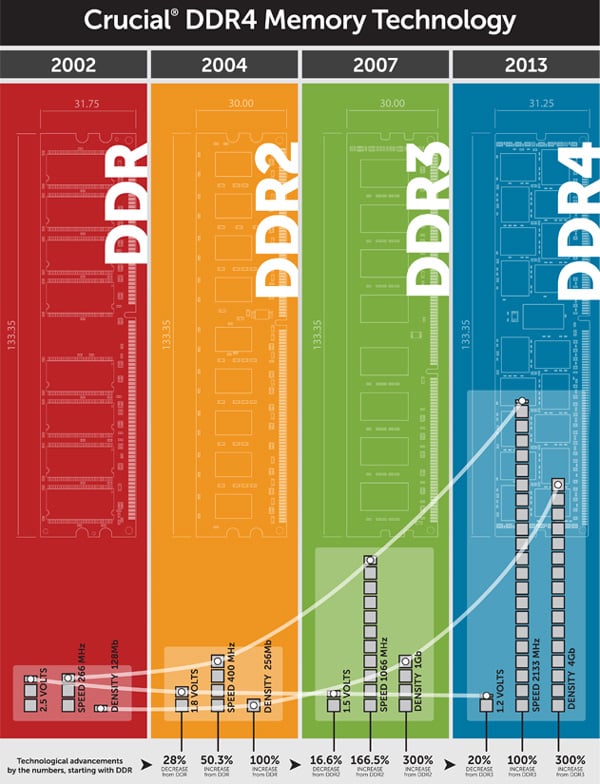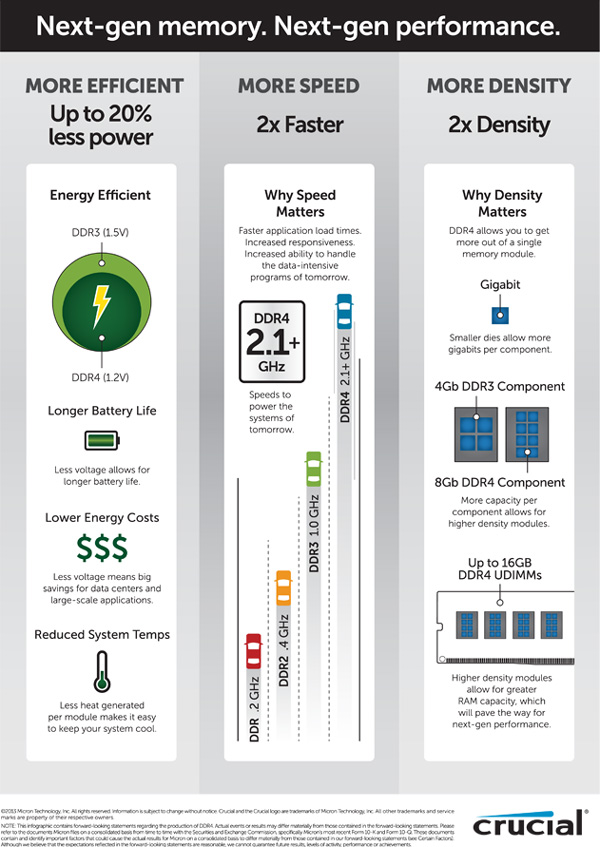DDR4 DRAM memory technology is set to replace DDR3 soon later this year, but what is DDR4 exactly, and what are the advantages of such technology compared to the DDR3? Well then, let’s take a brief look at DDR4, along the advantages that it promises to the table, with the help of a nice infographic from our friends at Crucial Memory.
EFFICIENT, FASTER, & HIGHER CAPACITY MODULES:
Compared to DDR3, the DDR4 technology features a lower power consumption @ 1.2v in order to operate at its standard frequency. Low voltage standards are around 1.05v, which is great for mobile devices. Capacity is a huge leap too at 16GB/stick, compared to DDR3’s 8GB/stick, thanks to DDR4’s higher density modules. Speed is rated at 2133Mhz, and is effectively twice as fast compared to the DDR3’s 1000Mhz standards. Theoretically, DDR4 is going to be much faster compared to DDR3, but will introduce higher latency compared to DDR3.
IN CLOSING:
The future of memory technology with DDR4 is looking great, but there are caveats. You see, DDR3 uses Multi-Drop BUS topology, while the next-gen DDR4 will utilize Point-to-Point topology. In layman’s term, DDR4 will only operate at Single Channel with 1 stick, Dual Channel with 2 sticks, and will only operate at Quad Channel with 4 sticks respectively. That said, you’re left with little headroom for upgrade, as you’re bound with a maximum of 32GB for Dual Channel configuration for example.
| Feature/Option | DDR3 | DDR4 | DDR4 Advantage |
|---|---|---|---|
| Voltage (core and I/O) | 1.5V | 1.2V | Reduces memory power demand |
| VREF inputs | 2 – DQs and CMD/ADDR | 1 – CMD/ADDR | VREFDQ now internal |
| Low voltage standard | Yes (DDR3L at 1.35V) |
Anticipated (likely 1.05V) |
Memory power reductions |
| Data rate (Mb/s) | 800, 1066, 1333, 1600, 1866, 2133 | 1600, 1866, 2133, 2400, 2667, 3200 | Migration to higher‐speed I/O |
| Densities | 512Mb–8Gb | 2Gb–16Gb | Better enablement for large-capacity memory subsystems |
| Internal banks | 8 | 16 | More banks |
| Bank groups (BG) | 0 | 4 | Faster burst accesses |
| tCK – DLL enabled | 300 MHz to 800 MHz | 667 MHz to 1.6 GHz | Higher data rates |
| tCK – DLL disabled | 10 MHz to 125 MHz (optional) | Undefined to 125 MHz | DLL-off now fully supported |
| Read latency | AL + CL | AL + CL | Expanded values |
| Write latency | AL + CWL | AL + CWL | Expanded values |
| DQ driver (ALT) | 40Ω | 48Ω | Optimized for PtP (point-to-point) applications |
| DQ bus | SSTL15 | POD12 | Mitigate I/O noise and power |
| RTT values (in Ω) | 120, 60, 40, 30, 20 | 240, 120, 80, 60, 48, 40, 34 | Support higher data rates |
| RTT not allowed | READ bursts | Disables during READ bursts | Ease-of-use |
| ODT modes | Nominal, dynamic | Nominal, dynamic, park | Additional control mode; supports OTF value change |
| ODT control | ODT signaling required | ODT signaling not required | Ease of ODT control, allows non-ODT routing on PtP applications |
| Multipurpose register (MPR) | Four registers – 1 defined, 3 RFU | Four registers – 3 defined, 1 RFU | Provides additional specialty readout |
In addition, no current motherboard and CPU in the market supports DDR4. Meaning you have to buy a new motherboard, and CPU to take advantage of the said technology which will be probably available upon the release of the next-gen chipsets and micro-processors. Reports suggests that Intel’s upcoming Enthusiasts grade Haswell-E chips will support DDR4, while AMD will support it probably in the late 2014 based on JEDEC’s roadmap. Like any other technological advancements, expect the initial cost of DDR4 to hurt your wallet.
Intel and several memory manufacturers showcased the DDR4 technology at the recently concluded Intel Developer Forum, and event suggests that DDR4 will see its first real world action with servers, rather than with consumer grade hardwares with the exception of the soon to be released Haswell-E which is based on Intel’s server grade chips.
AWESOME SAUCE: Crucial / Micron



The infographic at the top is misinformation, the highest non-OC DDR3 speed is 1866MHZ (1.9~GHZ), currently DDR4 maxes out at 3.6GHZ OC, while factory OC’d DDR3 runs at speeds up to 3.1GHZ out of the box with stock voltage, also, the density is a blatant lie since there are DDR3 DIMMs up to 32GB. Please, for the sake of science correct yourself and do your research better, this article is a shameful display of half-baked facts.
Oh and thus, the chart at the top is completely wrong too, also DDR2 goes up to 800MHZ, not 400MHZ, i would really like it if you explained yourself or improved this article.
DDR2 goes up to 1066 MHz actually, and DDR2 achieved 400 MHz by 2004. Technically, 2004 is also the year when it entered the 533 MHz territory, but 400 MHz is the prevailing speed on that year as far as consumer availability is concerned.
Consumer availability is imo not a good thing to base objective charts on.
The article is older than – when JEDEC released the Non-OC 1866 MHz standard DDR3. Same goes for everything that you have said.
Still makes the charts inaccurate and overproportioned, because OC standards are also supported by many OEMs, and it was not said that this article is in any way exclusive to JEDEC standards, even if that may be the case, there always was 1600MHZ, still rendering this chart inaccurate, sorry for my rude commenting up there, i got a little carried away.